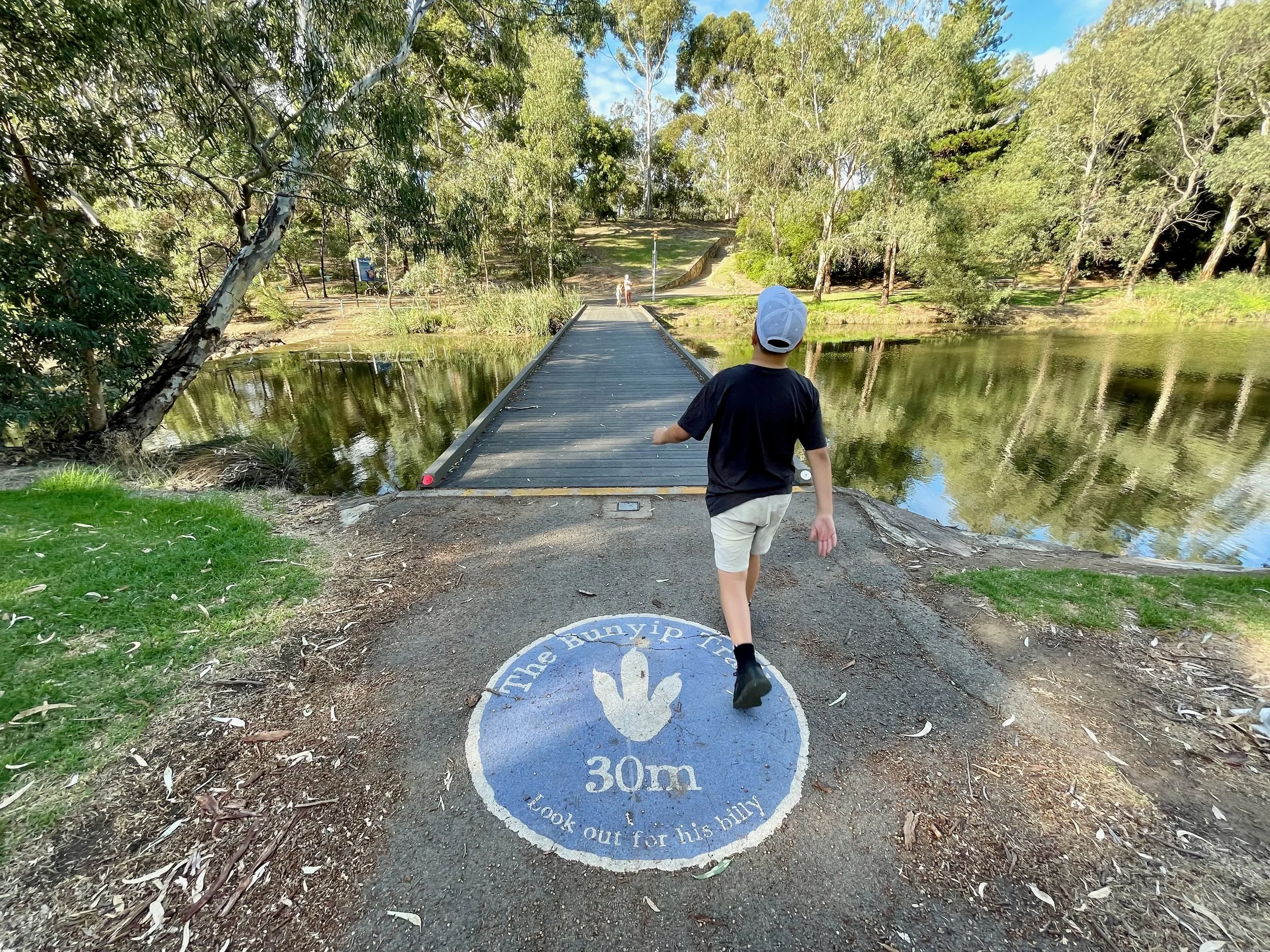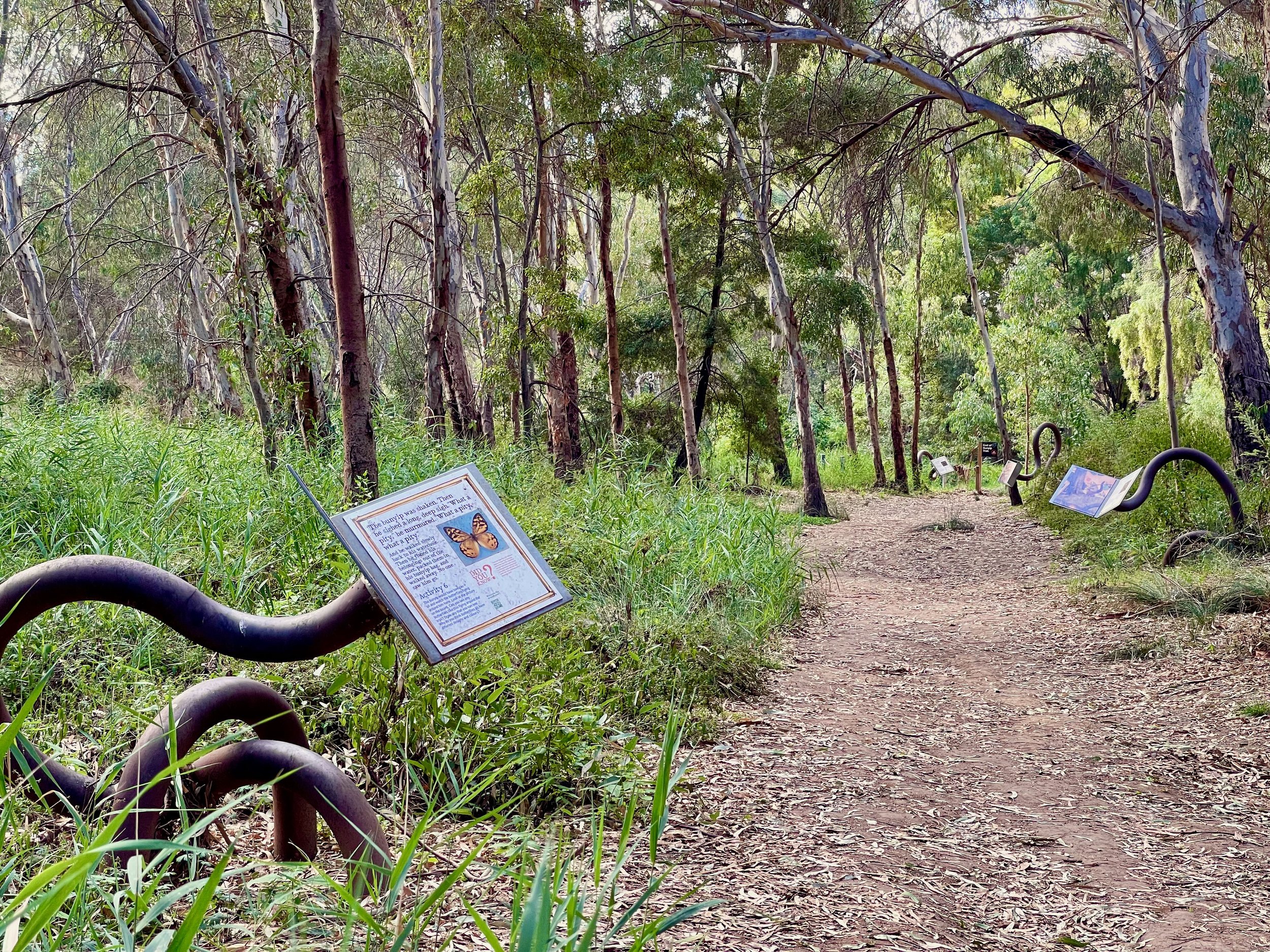by Carla Caruso
You probably know about the manicured parts of Bonython Park / Tulya Wardli in Park 27 – the playspace, the model boat pond, the picnic facilities.
However, you might not be aware of a nearby wilder, bushier space: John E. Brown Park (Park 27A).
Among its features, it’s home to the Bunyip Trail. For those looking to entertain kids these school holidays – or if you just love nature or books – it could be just the ticket.
But get in quick as the trail is closed from May to August due to the risk of localised flooding. (Care is also needed on rainy days; trees once had to be replanted after storms.)
The trail’s a joint production between the Children’s University Australia / University of Adelaide and the Adelaide City Council.
Opened back in 2016, it’s based on Queensland author Jenny Wagner’s popular ‘70s book, The Bunyip of Berkley’s Creek. It’s great to see the tale live on for other generations in this way too.
Kiri Hagenus, the director of the Children’s University Australia, told Story Box Library, the project came about through a community grant.
“The … council had an area of Bonython Park that had recently been revegetated with native flora,” Kiri said.
“Although the area was peaceful and beautiful, they felt it was very underutilised and were keen to see if we could create something using this particular space.
“I became quite excited when they told me that the area ended at a billabong. That’s when I had the ‘aha’ moment and the children’s book, The Bunyip from Berkeley’s Creek, sprang to mind.
Twins Sebastian and Alessio begin the trail. Photo: James Elsby.
“I thought it would be wonderful to create a story trail using the book, and incorporate interesting facts about the native flora, fauna and history of the area [too] in a way that pulled all these pieces together.”
The 260m-long trail encourages hands-on participation, with walkers completing a series of activities relating to the story at different points.
Learn interesting facts and read snippets of the iconic tale along the way. Photo: James Elsby.
You can download the activity booklet here before starting on the trail. Then, follow the bunyip footprints to the start of the trail on the eastern side of the footbridge beside the small weir (access from Gate 4 off Port Road, opposite Phillips Street).
Following the trail, you are encouraged to look for different animals and insects, compare wood debris and litter, guess the age of river red gums, and more.
The trail’s been left in its natural state as much as possible, helping to inspire discussions about nature. Photo: James Elsby.
For those wanting to dive deeper into topics, you can scan QR codes on the activity boards. When we visited, a few codes didn’t work. However, those that did took us to sites like Planet Ark (highlighting National Tree Day) and All Down Under (providing history on Waltzing Matilda).
There’s also a link to a part of the story being read by Australian singer-songwriter Nick Cave. However, this didn’t work for us. You can listen to it here, though.
At the end, you’re led to a billabong - and the story delivers a poignant point. “It has a message that children often confront, which is all about trying to find out who we are and how we fit in,” Kiri says. “Although you feel very sad for the bunyip at times, it ends on such a happy note; it’s a great life lesson.” Photo: James Elsby.
Fun facts are dotted throughout the signs - including that “butterflies taste with their feet, smell with their antennae, and are completely deaf”. And, of course, you also learn about the trail’s namesake, the bunyip.
One board’s QR code takes you to Kids.net.au, which says: “A bunyip (‘devil’ or ‘spirit’) is a mythical creature from Australian Aborigine mythology. According to this legend, bunyips are said to lurk in swamps, billabongs, creeks, riverbeds, and waterholes.
“At night, their blood-curdling cries can be heard as they devour any animal or human that venture near their abodes. Their favourite prey is human women. They also bring diseases.
“Descriptions of bunyips vary wildly. Common features in Aboriginal drawings include a horse-like tail, flippers, and walrus-like tusks.
“Although no documented physical evidence of bunyips has been found, it has been suggested that tales of bunyips could be Aboriginal memories of the diprotodon, which became extinct some 20,000 years ago.”
The trail takes about half an hour to meander. After retracing your steps along the River Torrens / Karrawirra Parri, you may like a fuel-up at revamped kiosk Cafe Bonython (below), just as we did.
Cafe Bonython is a hop, skip, and a jump away. Photos: James Elsby.











